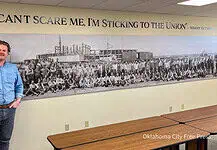OKLAHOMA CITY — The City of Oklahoma City’s Municipal Code – the set of citywide regulations that governs zoning, building codes, public health, and more – is set to be fully updated and overhauled for the first time in four decades.
Following last year’s update to the City’s Sign Code and the long-running, contentious debate over allowing homeowners to build Accessory Dwelling Units (ADUs) on their lots, City staff will now take a more holistic and comprehensive look at the full Municipal Code and update it for the modern OKC.
That means reconsidering how the City regulates everything from zoning to building permits to mixed-use construction, parking requirements, landscaping, and more.

It’s all in response to the goals of the City’s 2015 Comprehensive Plan, “PlanOKC,” which established guidelines for city growth, as well as the ever-growing number of special exemptions and case-by-case considerations that the Planning Commission has been hearing over the past decade.
“The number of special zoning cases and exemptions is a red flag that the existing code is not working,” Assistant City Planner Lisa Chronister told Free Press. “If everyone is needing to get a special zoning exemption, then that’s a big red flag. So let’s just update it.”
A modern city
According to Chronister and her Program Planning colleague Marilyn Allen, the reason for all of the special zoning requests and hearings is that the existing code is decades out of date and not compatible with the trends of modern business and city living.
“We’ve made little tweaks here and there over the years,” Allen said. “But really, this is a code from 1980.”
That means that the current City codes have plenty of rules regarding outdated, largely non-existent businesses like physical ticket offices for events, but don’t have any allowances for newer types of businesses like ghost kitchens or even drive-thru coffee stalls.
“We don’t even have anything in the current code for event centers,” Allen said. “There’s a lot of people that want to do event centers, but that’s not even contemplated in the existing code.”
Current codes also place too high an emphasis on parking in an age of rideshare services like Uber and delivery services like DoorDash and Amazon.
“If you go up Northwest Expressway toward MacArthur and Rockwell, you can see,” Chronister said. “There are so many giant parking lots through there and they’re mostly empty most of the time now. So what we’ve proposed, with some exceptions, is to mostly get rid of minimum parking.”

Mixed-use development
Plans for a new Municipal Code will better consider how to incorporate those kinds of newer business models, but also how to better incorporate the city’s rapidly growing population and housing needs, as well as the popular trends regarding where people want to live in the city.
The hard-fought new ADU regulations, which took effect Friday, are part of that new consideration, but there have already been discussions about further relaxing and rethinking residential codes to better handle demand and trends.
Much of that re-thinking has been focused on mixed-use development, making it easier for businesses and residences to mix in the city’s urban core.
One such development is The Oak near northwest Oklahoma City at Northwest Expressway and N. Penn across the intersection from Penn Square Mall, which is very nearly complete.
“You’ll see a lot of these developments like The Oak that have been done through special zoning exemptions,” Allen said. “But now we’re trying to meet the recommendations of the Comprehensive Plan by creating more streamlined zoning that just allows for that.”
It’s a way of substantially rethinking the wants and needs of Oklahoma City’s growing population following a century’s worth of planning and design concepts originally meant to keep mixed-use development to a minimum.
“It all goes back to the 1920s when people were living too close to industrial areas and things were catching on fire and were really unsafe,” Allen explained. “So they created these really strict separations between commercial and residential, and they went a little too far.”
Public health and safety
Updating the City’s Municipal Code isn’t just about trends and housing demand, though. It’s also about addressing the City’s responsibility to the health and safety of OKC residents.
That means designing the new code in a way that encourages walkability and prioritizes safety and comfort however possible.
“It was easy to separate uses like that in the Post-War years, because everyone had cars and could drive between places,” Chronister explained. “But in the last twenty years, we’ve started to realize that now we have to drive everywhere. We can’t walk. So our physical and respiratory health is going down from not getting enough activity and we’re seeing real air quality impacts because of emissions.”
Allowing and promoting more mixed-use development, where residents can live, shop, and enjoy leisure all easily just by walking or utilizing public transit, is a big step toward addressing those public health needs.
But they also have to consider recent data like 2023’s Heat Watch study, which examined the prevalence of “heat islands” across OKC caused primarily by those large, sprawling parking lots and rampant car emissions.
Even though a lot of the new code will be separated by rural, suburban, and urban areas, one element that will be citywide is the new landscaping codes, particularly parking lot landscaping,” said Chronister. “We’re going to ask that you provide more trees and more landscaping to reign in these giant paved lots that suck up heat and radiate it out and don’t provide any natural drainage for rainwater.”

Next steps
Now that the new ADU regulations – perhaps the most complex and contentious element of the code update – have been settled and are going into effect, Chronister said that she and the Planning Department can begin more earnest work on the full-scale overhaul of the Municipal Code.
“We’re going to start issuing sections of the new code for public comment at least through the end of this year,” said Chronister. “And we’ll be starting by focusing on Midtown and the ‘urban medium,’ just because that’s where there’s been the most demand for infill. But we’re not ignoring anyone, and we will get to hear from everyone as we go.”
But she’s quick to reassure residents that they’ll be working to consider and protect the unique characters of OKC’s many different neighborhoods and districts, rather than just creating blanket codes and allowances across the city.
“We’re not trying to make everybody like Midtown, and we’re not rezoning anybody,” she said. “One of the biggest things that we learned from the ADU conversation is that we need more engagement with the post-1950s and 60s neighborhoods in the city. We need way more. So we have a plan to do that.”
Brett Fieldcamp is our Arts and Entertainment Editor. He has been covering arts, entertainment, news, housing, and culture in Oklahoma for 15+ years, writing for several local and state publications. He’s also a musician and songwriter and holds a certification as Specialist of Spirits from The Society of Wine Educators.










